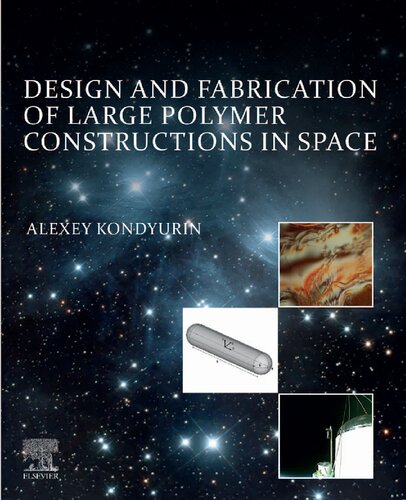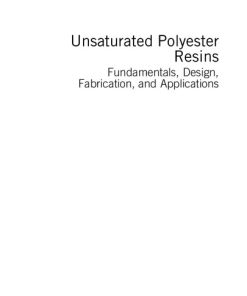Design and Fabrication of Large Polymer Constructions in Space 1st edition by Alexey Kondyurin 0128168042 9780128168042
$50.00 Original price was: $50.00.$25.00Current price is: $25.00.
Design and Fabrication of Large Polymer Constructions in Space 1st edition by Alexey Kondyurin – Ebook PDF Instant Download/DeliveryISBN: 0128168042, 9780128168042
Full download Design and Fabrication of Large Polymer Constructions in Space 1st edition after payment.

Product details:
ISBN-10 : 0128168042
ISBN-13 : 9780128168042
Author: Alexey Kondyurin
Design and Fabrication of Large Polymer Constructions in Space is a ground-breaking study of the polymeric materials, advanced chemical processes, and cutting-edge technology required in the construction of large polymer-based structures for space, when all steps in the process are carried out in the space environment, whether in orbit, in deep space, or on the surface of a moon, asteroid, or planet.
The book begins by introducing the fundamentals and requirements of large constructions and inflatable structures for space. The next section of the book focuses on the utilization of polymeric materials within the space environment, examining the effects on materials (vacuum, plasma, temperature), the possible approaches to polymerization both in space and in orbit, the preparation and structure of polymer composites, and the methods for testing materials and structures in terms of strength, defects, and aging. Three chapters then cover how these materials and techniques might be applied to specific categories of construction, including larger space habitats, supporting space structures, and ground infrastructure. Finally, the financial aspects, the consequences for human space exploitation, and the possible future developments are discussed.
Design and Fabrication of Large Polymer Constructions in Space 1st Table of contents:
Chapter 1. Constructions in space
1.1. First rockets, first satellites
1.2. Payload capacity of past and present space launch systems
1.3. Human flights
1.4. Multi-crew member ships: Space Shuttle and Energia-Buran
1.5. Space stations
1.6. Why do we need a large space construction?
1.7. Requirements for large space constructions
1.8. Mechanical deployment
1.9. Making in space
1.10. Robots in space
Chapter 2. Inflatable structures
2.1. History of inflatable structures
2.2. Inflatable structures in space
2.3. Inflatable structure projects
2.4. Folding methods
2.5. Inflation methods and equipment
2.6. Stability of an inflatable construction
2.7. Advantages and limitations
2.8. Rigidization of the inflatable construction
Chapter 3. Materials in the space environment
3.1. Space factors for Low Earth Orbit, Geostationary Earth Orbit, and deep space missions
3.2. Environmental factors on other planets
3.3. Space simulators
3.4. Materials experiments in space environment and simulators
3.5. Materials experiments in stratosphere
3.6. Structural transformations in polymers under high-energy particles
3.7. Chemical reactions in polymers exposed to radiation
3.8. Material selection and standards
3.9. Uncured materials in a free space environment
Chapter 4. Chemical curing of composite materials on Earth
4.1. Epoxy resins
4.2. Hardeners for epoxy resins
4.3. Epoxy compositions for space applications
4.4. Curing kinetics of epoxy resins
4.5. Ultraviolet curing kinetics
Chapter 5. Chemical curing in a vacuum
Chapter 6. Chemical curing in plasma and ion beams
6.1. Uncured solid epoxy resin in plasma
6.2. Cured solid epoxy resin in plasma
6.3. Liquid epoxy compositions in plasma
6.4. Liquid ultraviolet-curable composition in plasma
6.5. Mechanical properties of composite cured in plasma
Chapter 7. Chemical curing in temperature variations
Chapter 8. Chemical curing in flights
8.1. Stratospheric flight experiments
8.2. Space orbit flight experiments
8.3. Ground facility for curing in simulated spaceflight environment
Chapter 9. Composite wall structures
9.1. Selection of fibers and resins
9.2. Prepreg winding
9.3. Prepreg impregnation
9.4. Wall structure
9.5. Design of the construction
9.6. Windows and docking elements
9.7. Folding
9.8. Storage requirements on the Earth
9.9. Launch requirements
9.10. Storage in orbit
9.11. Deployment in space
Chapter 10. Curing process in Earth orbit
10.1. Lagrange L2 point
10.2. Earth orbits
10.3. Moon orbit
10.4. Mars orbit
10.5. Venus orbit
10.6. Construction on surface of other celestial bodies
10.7. Optimization of orbital flight
Chapter 11. Evaluation of construction
11.1. Evaluation of a construction on Earth
11.2. Control of unfolding in orbit
11.3. Control of curing in orbit
11.4. Evaluation of cured construction
11.5. Defect detection and healing
11.6. Use of old constructions and materials
Chapter 12. Large space habitat
12.1. Common systems for all crew missions
12.2. Some examples of a large space habitat
Chapter 13. Supporting space structures
13.1. Solar panels
13.2. Thermal shields
13.3. Large reflector
13.4. Large solar sail
13.5. Large antenna
13.6. Technician set
13.7. Space garage or hangar
13.8. Rescue systems in space
Chapter 14. Ground infrastructure
14.1. Cosmodrome structures
14.2. Large-scale winding machines
14.3. Packing (folding) machines
14.4. Transport container
Chapter 15. Prospective finances and investment
15.1. Cost of large space constructions
15.2. Cost of research and development
15.3. Customers
15.4. Investment projects of space technologies
People also search for Design and Fabrication of Large Polymer Constructions in Space 1st:
design polymers
design and fabrication
design polymerics santa ana
construction polymers
polymer design
Tags: Design, Fabrication, Large Polymer, Constructions, Alexey Kondyurin
You may also like…
Engineering
Engineering - Industrial Engineering & Materials Science
Uncategorized
Media and Communication in the Soviet Union (1917–1953): General Perspectives 1st Edition
Politics & Philosophy - General & Miscellaneous Philosophy












